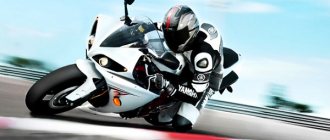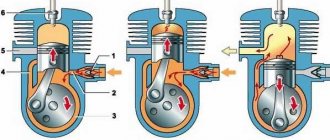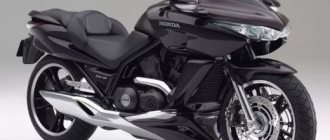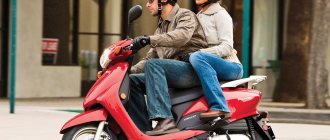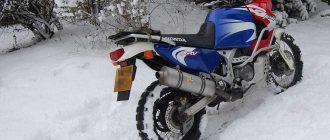It is generally accepted that driving a scooter is the prerogative of exclusively young motorcyclists and older people. This opinion was formed due to the relative simplicity of the device and, as a consequence, the control of this two-wheeled vehicle. It is difficult to argue to what extent such a statement is true, but, as qualified experts advise, you should never take riding a scooter lightly. The latter is most often the sin of those who get behind the wheel of a scooter after long-term use of two-wheeled units with a large number of cubes.
It’s not difficult to guess what the consequences of such a frivolous attitude are. This is an increased danger on the road, not only for the most careless driver, but also for those around him. Typically, such a biker is capable of causing no less harm than a young beginner. In any case, regardless of the experience and number of years in the saddle of other two-wheeled vehicles, a novice scooter driver must follow a number of basic recommendations.
General information
The question of how to ride a scooter includes many aspects. The position of the driver's body when starting to move is important. The center of gravity should be located closer to the steering wheel or lie down on it so that when accelerating the vehicle does not stand on its rear wheel. This usually happens when a tall driver sits on the edge of the seat farthest from the steering wheel. After reaching a speed of 30 km/h, you can straighten your body and position yourself to your liking.
Beginning scooter drivers should slowly and gradually turn on the gas and release it after the vehicle begins to accelerate, applying gas afterwards when the engine slows down. This will lead to the formation of the skill of correct gas dosage.
You should not make sudden movements or jerk to the sides when operating the scooter, especially when moving at high speed.
It is important to learn how to stop correctly by combining the forces of the front and rear brakes. This is the basis of driver safety. It should be remembered that an attempt to urgently stop a vehicle moving at high speed may result in the wheels completely blocking and the scooter skidding. For beginners, it is advisable to use exclusively the rear brake at first. The front one should be studied only after sufficient mastery of the back one. Enabling it allows you to maintain control over the movement during a turn, while the brake of the front wheel impairs the traction of the rear wheel and the effectiveness of its braking.
Seasonality and weather conditions
It is better to use a scooter in the warm season, when there is a stable daily above-zero temperature outside. This is, of course, in summer, late spring and early autumn. During this period, riding two-wheelers is a pleasure. But if it rains, it is better to refrain from traveling for the following reasons:
- bad visibility
- the driver is forced to slow down and, as a result, may become a nuisance on the road
- the road becomes slippery and the scooter often skids, especially when braking
Therefore, in rainy weather it is better to travel by car or public transport.
For safety reasons, we also do not recommend riding a scooter in winter.
It is technically not suitable for this time of year. In the cold it is difficult to maintain balance on ice, and the plastic on the scooter becomes brittle and even with a slight impact breaks easily. We advise you to forget about the scooter during the winter period.
How to learn to ride a scooter
Either by training yourself or by using the services of a professional instructor, you can master all the intricacies of the trip. Those who have successfully completed the training stage themselves advise beginners to remember and at the first start not to hold the right throttle too tightly, turning it slowly.
When the scooter starts moving, you must be ready to release it immediately. If the vehicle takes off too quickly, this is very important. The stop will occur immediately after releasing the throttle.
When choosing a site for training, you should prefer uncrowded places away from the roadway.
A little about age
How long can you start riding a scooter? This is important information, any deviation from which will result in heavy fines. The current version of the Road Traffic Rules equates this transport to mopeds and provides the same requirements for their drivers. Including the question of what license one can have to ride a scooter. The right to drive is ensured by a valid driver's license with an authorized category M and reaching the age of 16 years. Having documents with any other driving category makes it possible to drive a scooter without opening the specified M category.
Management Basics
Sergey is the author of a travel blog. Many are interested not only in the principles of driving, but also in the specifics of Asian countries, where it is almost impossible to do without two-wheeled transport. While in Asia, Sergey decided to make a video tutorial on how to master it from scratch. Viewers will find out whether a license is needed, how much the rent costs, where the gas tank is located, and what “magic” word can be used to fill it up. Next comes practical information: maintaining an upright position, the sequence of manipulations for the correct start, competent turn, braking, parking.
Important to remember!
It’s impossible not to talk about what it takes to ride a scooter. When getting behind the wheel, the scooter rider must always have in his pocket a driver’s license (a temporary permit that similarly confirms the rider’s right to operate a scooter) and an insurance policy.
The Traffic Rules also require you to wear a special helmet while driving. There is no legal requirement for a scooter passenger to have one.
Equipment
A scooter, unlike a car, does not have glass or a body, which can partially protect the driver from injury in the event of an emergency. For this reason, for safety reasons, scooter riders and passengers should not ride on the road with their helmets unfastened. A helmet is required, but other equipment is at your discretion. Whatever is comfortable, you can ride in, in any casual clothes and shoes. You can even do without motorcycle glasses if you ride at speeds up to 40 km/h. But it is advisable to always wear gloves, even if they are cotton construction gloves, 20 rubles each. For driving in twilight and darkness, it is advisable to have reflective elements on clothing.
Interesting points
The topic of how to ride a scooter correctly is very multifaceted. In particular, drivers will find this information useful. Road traffic rules oblige scooter riders to move on the right edge of the roadway or in a special lane for cyclists. There is no prohibition on driving on the side of the road when this does not create obstacles for pedestrians. It should be noted that by establishing the order of scooters moving in one row on the right side of the roadway, this transport was allowed to go around obstacles, for example, in the form of a bus standing at a stop.
For scooters, as well as for other types of transport, it is mandatory to turn on the headlights during the daytime.
Passengers
Transporting passengers is possible, but a scooter has its own characteristics:
- A transport driver must have at least 2 years of driving experience.
- Children under 7 years old can be passengers on a scooter if there is a specially equipped seat.
- The scooter must be designed to carry passengers.
Prohibitions for scooter drivers:
- Transportation of large cargo with dimensions exceeding the length or width of the vehicle by more than 0.5 meters.
- Crossing the road at a pedestrian crossing.
- No hands on the steering wheel (at least one hand).
- It is prohibited to turn around or make a left turn on a road with tram tracks or where there are several lanes for traffic in one direction. It does not matter whether the location of the tram tracks is in the middle or on the side of the road. The ban applies in any case.
- Towing of vehicles.
Scooter drivers moving on a bicycle path are subject to a priority rule, according to which they are obliged to give way to vehicles traveling on the road at the intersection of the bicycle path with the highway if there is no intersection there.
Cornering
An equally important point is how to drive the scooter when cornering. There are many myths and misconceptions about this, while experts are more clear.
You should first visually calculate the entry trajectory and adjust the speed limit to the required level. At increased speeds, there is a high probability of a decrease in adhesion characteristics with the road surface, therefore, it is necessary to start the maneuver moderately. Compliance with this rule will ensure controllability during the turn. There are two ways to enter a turn:
- tilting the body in unison with the tilt of the scooter;
- Tilt of the vehicle only (applicable at low speeds).
The first method is the most common and universal. Experienced riders of both small and large motorcycles describe it as safe and comfortable. The second one requires more skill and is used to enter a turn with a reduced radius.
It is not recommended for beginners to use it for the first time. It’s also worth remembering that before starting this maneuver, you should definitely finish braking.
Following these simple but important rules will not only make driving a scooter easier and safer, but will also make any trip pleasant and comfortable.
Where to ride a scooter
Due to its small size and weight, efficiency and accessibility, a scooter is a convenient and popular form of transport in any area. At the same time, questions about how to ride a scooter in rural areas do not arise. But in the presence of heavy traffic, for example, within the city, it is important for the scooter rider to exercise increased caution on the road.
When driving within the city, the driver should adhere to certain rules:
- Be sure to always drive with low or high beam headlights on.
- At the level of the rear door of the car there is a dead zone of visibility for the driver of the car. It is dangerous to drive a scooter in it; a motorist may not be able to see the two-wheeled vehicle on his side.
- When driving alongside cars in a parking lot, you need to be careful for fear of doors suddenly opening or a parked car starting to move.
- Don't be shy about honking frequently. Also, the sound of the doodle should be loud enough for car drivers to notice the moving scooter in time.
- It is better to drive through intersections when the traffic light is green, while carefully monitoring the road conditions on different sides and in the mirrors. A scooter rider should avoid rushing traffic at a yellow light, as there is a great danger that you will not be noticed and will be hit.
- It is best to store the key fob for an alarm installed on a scooter in a place that is further away from the ignition key, in a convenient pocket or with a spare ignition key. This is done to prevent accidental operation of the system.
- Good technical condition of a vehicle when driving in the city is one of the decisive factors for driver safety. When driving out onto the road, you should be sure that the scooter’s transmission is in perfect condition. If one of the wheels jams at speed, you may fall with serious consequences. It is better not to skimp on the condition of rubber, shock absorbers, bushings, pads and other important parts of the mechanism; the life and health of the driver may depend on this.
Test rides
As noted above, it takes very little time to get used to the scooter. Key points to consider on your first trips:
- acceleration control,
- correct braking
- and selection of cornering speed.
Simple rules for beginners
- You should not immediately go onto public roads and try to move at the speed of the flow.
- It is better to exchange the first ten kilometers on the odometer in safe, deserted roads or special areas.
- The speed for the first time should be limited to twenty kilometers per hour.
We hope these tips will help you in mastering the scooter. We wish you good luck and smooth roads!
Additional Tips
When driving around the city, vehicles must be equipped with two mirrors. Otherwise, you will have to turn your head often, and this is quite annoying when you are required to wear a special helmet. When adjusting the mirrors, it is necessary to take into account that the left one should capture the corresponding part of the road lane as much as possible, and the right one should view the situation behind the driver. This allows you to use them most effectively. Reduced monitoring of the situation on the right is due to the fact that, according to traffic rules, a scooter is only allowed to ride in the right lane.
After reading the above information, you will never wonder about how to ride a scooter again.
Gasoline level in the tank
Any new scooter should be fueled. Even if there is something splashing in the tank, there is no guarantee that the amount of fuel poured will be enough for the scooter to reach its destination.
If there is a gas station near your place of purchase, you can try to refuel there. Otherwise, you need to stock up on a can of gasoline in advance, as well as a funnel, so as not to miss the filler hole.
How not to overfill fuel
Some novice motorcyclists are afraid of overfilling their fuel. This definitely won’t happen when refueling at a gas station, since the gas nozzles automatically stop supplying gasoline when it gets close to the edge.
It is also easy to avoid overfilling by refueling the scooter from a canister, since the fuel container always has a maximum volume. You can choose a canister that does not exceed the volume of the tank, or fill the tank with only part of the fuel from the canister if the canister is too large. The surest way is to periodically check the level of filled fuel visually by removing the funnel from the neck of the tank. However, no one forbids using the scooter’s built-in capabilities for this, namely the fuel level indicator. To activate it, it is enough to turn the ignition key one notch to supply energy to the devices.
Safety precautions when refueling
Remember safety precautions when refueling - there should be no open flame near an open gas tank. You also need to remember the need to close the filler hole at the end of the procedure, so as not to smell of gasoline through and through during the trip.
